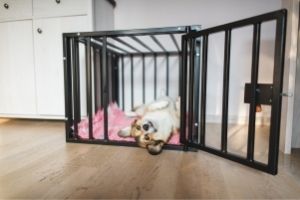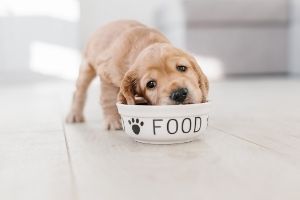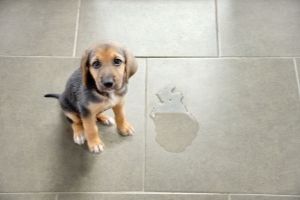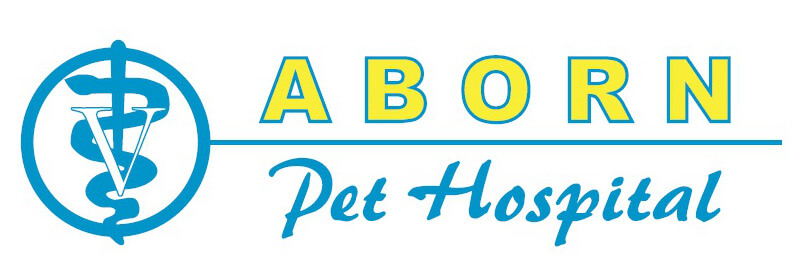You’ve brought your much-anticipated new puppy home and are delighted with this adorable little creature who just wants to play, cuddle, love you, and let you revel in that heavenly puppy breath. However, within the first hour, you’re reminded of the daunting task of potty training after they leave their first “present” on your carpet.
Sadly, lack of training is one of the top reasons dogs are surrendered to shelters by owners. The task of potty training is often considered after the fact or assumed to be easy, and new puppy owners become overwhelmed at the long-term consistency and patience required. As veterinarians, we want dog owners to be well-informed and ready to handle the process – which doesn’t have to be stressful or take a long time if done right.

1. Enlist Crate Training
Many new dog owners are surprised to learn that using a crate is, in fact, humane. Dogs are den animals by nature and feel comfortable and safe in small, confined areas. That’s why they hide under your bed or behind the couch during a thunderstorm or when they hear 4th of July fireworks. Whether you provide a crate or not, your puppy will find their own little safe haven when they’re feeling scared – so you might as well capitalize on this tendency and crate train them for the conveniences it offers.
Dog crates are a powerful tool to leverage in the potty-training process, during which time they also become accustomed to it for when they’re left home alone or traveling. Dogs are very clean creatures and will go to great lengths to avoid soiling their immediate living space. Therefore, they will not eliminate in a crate unless they’re put in a dire situation and have no other choice. The size of your dog crate is critically important – if too large, they will find a corner to dedicate to eliminating. The crate should be just large enough for the dog to lie down, stand up, and turn around.
When your puppy feels the urge to go, they will typically whine and/or paw at the crate door. Act quickly and take your puppy immediately from the crate to a designated area of your yard. Once they’re done, reward them and take them right back to the crate. Over time, they will begin to associate the yard as the appropriate place to eliminate, and that you react by bringing them outside when they alert you.
First-time dog owners need to realize that a puppy does not need to be confined to a crate 100% of the time while potty training. They need plenty of exercise, playtime, and human companionship as well. Just be sure to take them outside before returning them to the crate.
2. Take Them Out, and Then Take Them Out Again
The smaller the puppy, the more frequent the trips to the yard should be. A smaller puppy means a smaller bladder. From ages 8-16 weeks, puppies should be let outside about every 30-40 minutes during the day and every 4-6 hours during the night. We know this can feel like a lot, particularly initially, but this will pay off huge potty training dividends in the long term.

3. Stick to a Consistent Diet
Due to their small bladders and immature digestive system, puppies can only tolerate so much food and water at once. Therefore, it’s recommended to feed your puppy at least three small meals a day of high-quality food specifically made for puppies.
Feed your puppy at very consistent times, and you’ll quickly note how soon they need to eliminate after eating. Based on that amount of time and the subtle signs they’re giving that they might need to go quickly, take them outside. Avoid giving them any opportunity to eliminate inside, and you’ll find the potty-training process is quicker than expected.
Also, be sure to stick with the same type of food, and if you need to change the brand, wean them onto the new food over several days. If you skip the weaning process, your puppy could be left with a distressed belly and resulting diarrhea. Puppies have a much harder time controlling diarrhea, so you’ll find yourself with more messes to clean up and several steps backward in the potty-training process.
4. Adhere to a Routine
The consistency rule also applies to naps and playtime. Puppies are much more likely to need to eliminate after they wake up and after exercise, so make a habit of taking them right outside in either scenario.

5. Use Excessive Praise
Dogs are very in tune with their owner’s tone of voice and facial/body language, and they have an innate desire to please. They know when you’re upset, and they know when you’re happy with them. When your puppy eliminates outside, shower them with praise. Cheer, clap, say “good puppy,” and give them a small puppy-friendly treat or special squeaky toy. While it might feel silly and excessive, your puppy will understand their cherished owner approved their actions – and it resulted in a tasty treat or reward. Don’t worry; you don’t have to do this forever!
6. Avoid Punishment
Several old-school discipline methods should be avoided, such as the act of pushing your puppy’s nose close to the mess while chastising them for the action. Scolding is also non-productive and confusing to your puppy. All they know is they had to eliminate, and you didn’t give them the opportunity to do so outside – which is on you for not paying attention to the schedule or seeing the signs. Again, what they do understand is praise, so go overboard, and your puppy will thank you by repeating the good behavior over and over again.

7. Handle Accidents Nonchalantly
When your puppy does have an accident – and it will happen – clean it up with very little fuss. If you happen to catch your pup starting to eliminate inside, clap loudly or make a loud verbal sound to distract them and pick them up immediately to go outside. Offer praise even if they started inside but finished outside. Be very consistent with your routine and corrections. All members of the household should be part of the training process. Dogs want to please us, and they typically respond well to a consistent schedule.
Remember, prevention is the key to successful potty training. The fewer opportunities your puppy is given to eliminate inside, the quicker the potty-training process will be. Learn your puppy’s habits before they eliminate – like sniffing, circling, and an immediate stop to playtime. Your new motto should be, "When in doubt, take them out!" Even if you take them outside five times in a row with no results, that sixth time will be a success, and your puppy is that much closer to being house trained.
As veterinarians, we want to set you up for success in puppy potty training so, if you have any questions or need more guidance, please give us a call!

